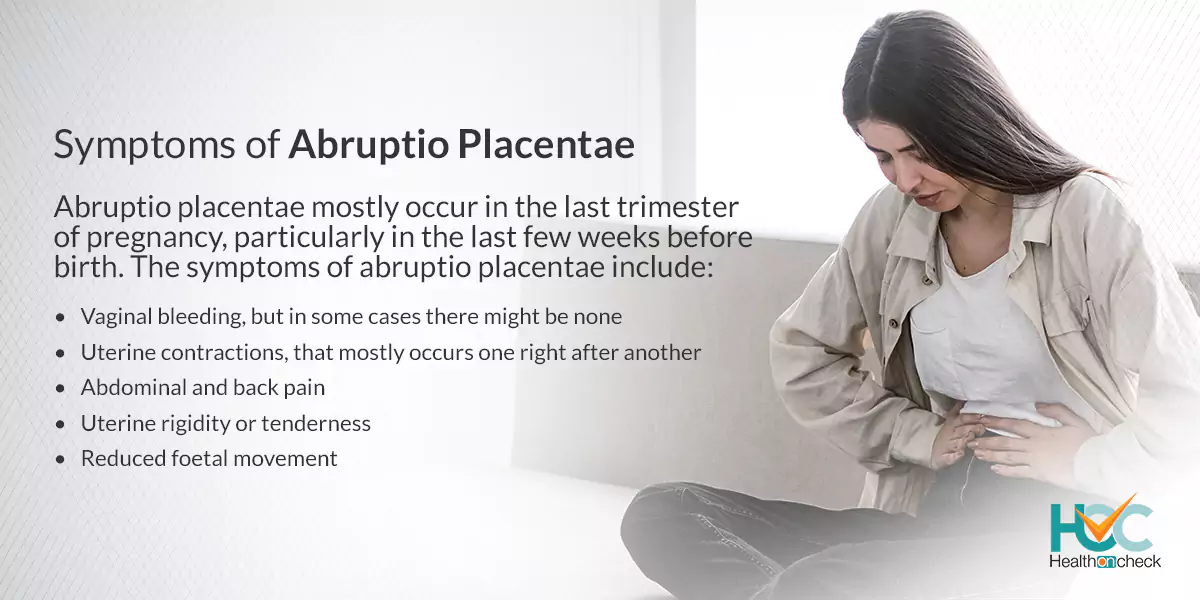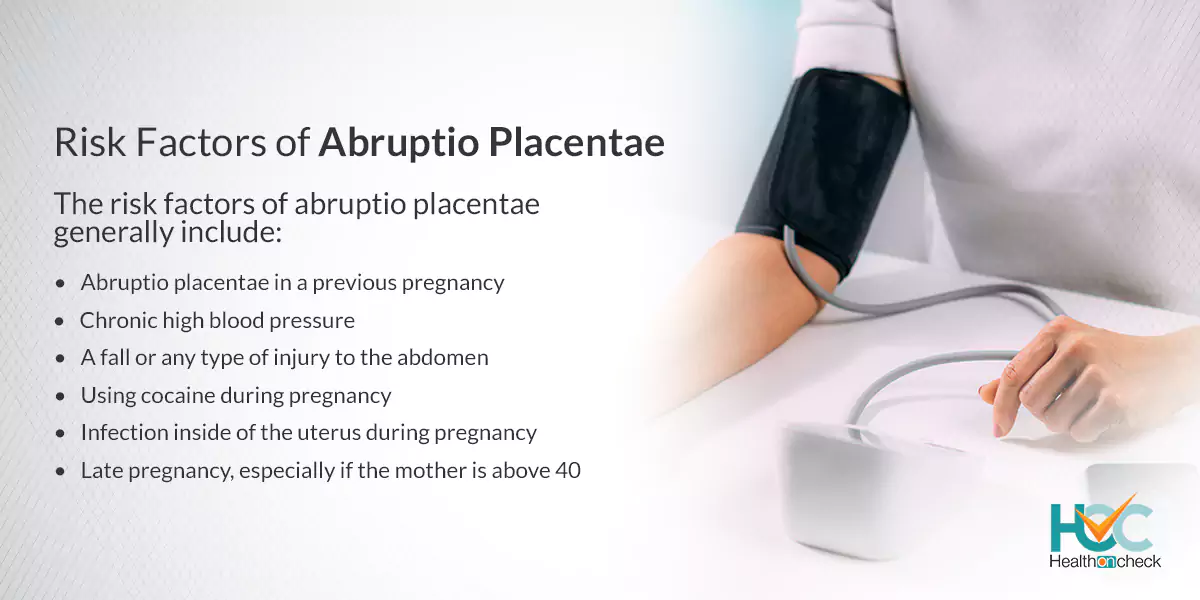What is Abruptio Placentae?

Abruptio placentae, also known as placental abruption is a rare but serious complication of pregnancy. During pregnancy, the placenta develops in the uterus which gets attached to the wall of the uterus and supplies the baby with oxygen and nutrients. Abruptio placentae happens when the placenta partly or totally gets separated from the inner wall of the uterus before delivery. It can reduce or block the baby’s supply of nutrients and oxygen which can lead to heavy bleeding in the mother. Abruptio placentae mostly occur suddenly and if left untreated, both the mother and the baby’s lives can be in danger.
What are the Types of Abruptio Placentae?
The types of abruptio placentae include:
– Partial abruptio placentae
It happens when the placenta is not completely detached from the uterine wall.
– Complete or total abruptio placentae
It happens when the placenta is completely detached from the uterine wall. It usually causes more vaginal bleeding linked with this type of abruption.
– Revealed abruptio placentae
It causes moderate to severe vaginal bleeding that you can notice.
– Concealed abruptio placentae
In this type, there is little or no visible vaginal bleeding because the blood gets trapped between the placenta and uterine wall.
What are the Symptoms of Abruptio Placentae?
Abruptio placentae mostly occur in the last trimester of pregnancy, particularly in the last few weeks before birth. The symptoms of abruptio placentae include:
– Vaginal bleeding, but in some cases there might be none
– Abdominal and back pain
– Uterine rigidity or tenderness
– Uterine contractions, that mostly occurs one right after another
– Reduced foetal movement
What are the Causes of Abruptio Placentae?
The exact cause of abruptio placentae is not yet known but possible causes might include trauma or injury to the abdomen from any kind of accident or fall, for instance — quick loss of the fluid surrounding and cushioning the baby in the uterus (amniotic fluid). Certain lifestyle choices or abdominal trauma can augment your risk for abruptio placentae.
What are the Risk Factors of Abruptio Placentae?
The risk factors of abruptio placentae generally include:
– Abruptio placentae in a previous pregnancy
– Chronic high blood pressure
– Hypertension-related problems during pregnancy, such as eclampsia, preeclampsia, or HELLP syndrome
– A fall or any type of injury to the abdomen
– Smoking
– Using cocaine during pregnancy
– Early rupture of membranes, that leads to leakage of amniotic fluid before the end of pregnancy
– Infection inside of the uterus during pregnancy
– Late pregnancy, especially if the mother is above 40
What are the Complications of Abruptio Placentae?
Abruptio placentae might cause life-threatening problems for both baby and mother.
For the mother, abruptio placentae can cause complications such as:
– Shock because of blood loss
– Blood clotting issues
– A blood transfusion requirement
– Failure of the kidneys or other organs because of blood loss
– The need for a hysterectomy might arise if uterine bleeding is uncontrollable
For the baby, abruptio placentae can cause complications such as:
– Not getting enough nutrients might cause restricted growth
– Not able to get enough oxygen
– Premature birth
– Stillbirth
How Abruptio Placentae is Diagnosed?
If your doctor suspects abruptio placentae, he will carry out a physical exam for checking uterine tenderness or rigidity. To determine possible sources of vaginal bleeding, your doctor may recommend blood and urine tests along with an ultrasound.
During an ultrasound, high-frequency sound waves will produce a detailed image of the uterus on a monitor which helps to diagnose the condition. However, it’s not always possible to notice or see an abruptio placentae on an ultrasound.
What are the Treatment Options Available for Abruptio Placentae?
Reattaching a placenta that’s separated from the wall of the uterus is not possible and the treatment options for abruptio placentae are mostly based on the circumstances:
– The baby isn’t near full term
In case the abruption is mild, the baby’s heart rate is normal and it’s too early for the baby to be born, the mother might be hospitalised for close monitoring. If the bleeding stops and the baby’s condition is stable, she might be released from the hospital and she can rest at home.
Medication might be given to the mother to help the baby’s lungs get mature and to protect the baby’s brain, and also if early delivery is necessary.
– The baby is near full term.
Usually, after 34 weeks of pregnancy, if the abruptio placentae seem mild and not severe, a closely monitored vaginal delivery may be possible. If the abruption worsens or gets the baby into health problems, an immediate delivery — usually by C-section is required.
For severe bleeding, a blood transfusion might be needed.
Living with Abruptio Placentae
The outcome of this condition is usually based on the severity of the symptoms and the timeline of pregnancy. If diagnosed with abruptio placentae, then you should be monitored closely and often. Watch for any changes in symptoms and discuss them with your doctor as soon as possible. The two factors affecting the survival rate are gestational age at birth and the severity of the abruption. Early detection, close monitoring, and quick treatment are helpful to reduce complications
Whom to Consult?
Abruptio Placentae is a rare, yet serious condition one can develop during pregnancy. You need to talk to your doctor if you experience symptoms such as vaginal bleeding, pelvic pain, or cramping. Abruptio placentae need to be diagnosed and treated promptly to make sure that you and your baby are healthy.






